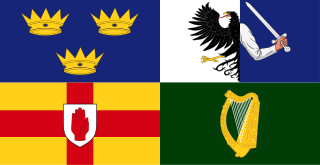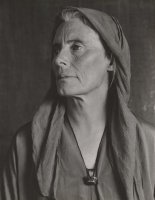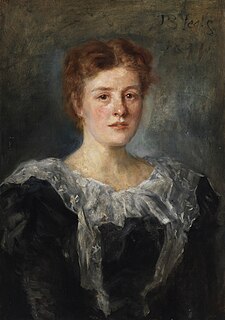History
The aim of the paper was to publicise and propagate the objectives of the IAOS, which set up dairy co-operative societies and co-operative banks, and introduced co-operation among Irish farmers by proving the benefits obtainable through more economical and efficient management. Its headquarters were initially in the IAOS building in Dublin, 84 Merrion Square. The newspaper's first editor was Thomas A. Finlay, followed by T. P. Gill and H. F. Norman. In 1905, George William Russell became editor. A major contributor of articles and essays was Susan L. Mitchell, who became assistant editor. [2] It was the first publication to publish James Joyce, with his short story "The Sisters" in 1904.
It ceased publication in 1918, but was afterwards revived in October 1921. In 1923 it was amalgamated with the Irish Statesman , and in this format it continued, under the editorship of George William Russell, until 1930. [3]

Aos sí is the Irish name for a supernatural race in Celtic mythology – spelled sìth by the Scots, but pronounced the same – comparable to fairies or elves. They are said to descend from either fallen angels or the Tuatha Dé Danann, meaning the "People of Danu", depending on the Abrahamic or pagan tradition.

William Butler Yeats was an Irish poet, dramatist, writer and one of the foremost figures of 20th-century literature. He was a driving force behind the Irish Literary Revival and became a pillar of the Irish literary establishment who helped to found the Abbey Theatre, and in his later years served two terms as a Senator of the Irish Free State.

Isabella Augusta, Lady Gregory was an Irish dramatist, folklorist and theatre manager. With William Butler Yeats and Edward Martyn, she co-founded the Irish Literary Theatre and the Abbey Theatre, and wrote numerous short works for both companies. Lady Gregory produced a number of books of retellings of stories taken from Irish mythology. Born into a class that identified closely with British rule, she turned against it. Her conversion to cultural nationalism, as evidenced by her writings, was emblematic of many of the political struggles to occur in Ireland during her lifetime.

Maud Gonne MacBride was an English-born Irish republican revolutionary, suffragette and actress. Of Anglo-Irish descent, she was won over to Irish nationalism by the plight of evicted people in the Land Wars. She actively agitated for Home Rule and then for the republic declared in 1916. During the 1930s, as a founding member of the Social Credit Party, she promoted the distributive programme of C. H. Douglas. Gonne was well known for being the muse and long-time love interest of Irish poet W. B. Yeats.
Brian Coffey was an Irish poet and publisher. His work was informed by his Catholicism, his background in science and philosophy, and his connection to French surrealism. He was close to an intellectual European Catholic tradition and mainstream Irish Catholic culture. Two of his long poems, Advent (1975) and Death of Hektor (1979), were widely considered to be important works in the canon of Irish poetic modernism. He also ran Advent Books, a small press, during the 1960s and 1970s.

George William Russell who wrote with the pseudonym Æ, was an Irish writer, editor, critic, poet, painter and Irish nationalist. He was also a writer on mysticism, and a central figure in the group of devotees of theosophy which met in Dublin for many years.
The Irish Literary Revival was a flowering of Irish literary talent in the late 19th and early 20th century.
Events in the year 1906 in Ireland.

Sir Horace Curzon Plunkett, was an Anglo-Irish agricultural reformer, pioneer of agricultural cooperatives, Unionist MP, supporter of Home Rule, Irish Senator and author.

Ella Young was an Irish poet and Celtic mythologist active in the Gaelic and Celtic Revival literary movement of the late 19th and early 20th century. Born in Ireland, Young was an author of poetry and children's books. She emigrated from Ireland to the United States in 1925 as a temporary visitor and lived in California. For five years she gave speaking tours on Celtic mythology at American universities, and in 1931 she was involved in a publicized immigration controversy when she attempted to become a citizen.

Alexander Martin Sullivan was an Irish Nationalist politician, lawyer and journalist from Bantry, County Cork.
George Otto Simms was an archbishop in the Church of Ireland.
The High Sheriff of County Galway was the Sovereign's judicial representative in County Galway. Initially an office for lifetime, assigned by the Sovereign, the High Sheriff became annually appointed from the Provisions of Oxford in 1258. Besides his judicial importance, he had ceremonial and administrative functions and executed High Court Writs.
Lough Cullen is the only lake in County Kilkenny, Ireland. The lake has numerous legends attached to it.
Robert Anthony Welch was an Irish author and scholar.
The Irish Monthly was an Irish Catholic magazine founded in Dublin, Ireland in July 1873. Until 1920 it had the sub-title A Magazine of General Literature.

Susan Langstaff Mitchell was an Irish writer and poet, known for her satirical verse.
Ellen O'Leary (1831–1889) was an Irish poet who sympathised with the Fenian movement. She was the sister of Irish separatist and leading Fenian John O'Leary.
The Irish Agricultural Organisation Society (IAOS) was an agricultural association in Ireland which advocated, and helped to organise, agricultural cooperativism, including mutual credit facilities. From its establishment by Sir Horace Plunkett in 1894, it quickly became an important element of the Irish economy and laid the foundations of the successful Irish dairy industry.









